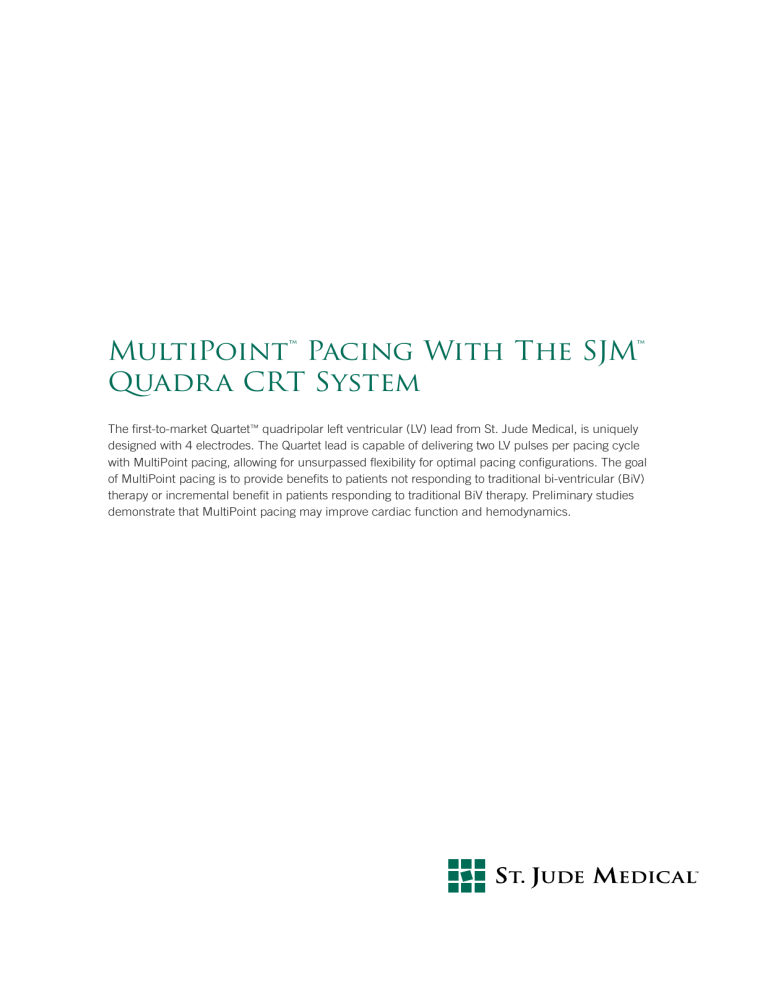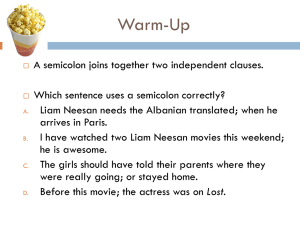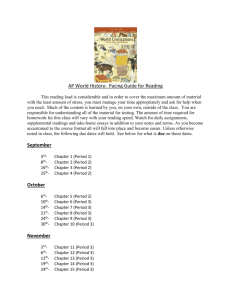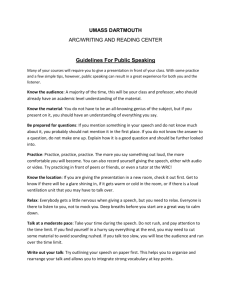MultiPoint™ Pacing Clinical Compendium

MultiPoint™ Pacing With The SJM™
Quadra CRT System
The first-to-market Quartet ™ quadripolar left ventricular (LV) lead from St. Jude Medical, is uniquely designed with 4 electrodes. The Quartet lead is capable of delivering two LV pulses per pacing cycle with MultiPoint pacing, allowing for unsurpassed flexibility for optimal pacing configurations. The goal of MultiPoint pacing is to provide benefits to patients not responding to traditional bi-ventricular (BiV) therapy or incremental benefit in patients responding to traditional BiV therapy. Preliminary studies demonstrate that MultiPoint pacing may improve cardiac function and hemodynamics.
Improved CRT Response: Hemodynamic and
Cardiac Function Benefits
The quadripolar left ventricular (LV) lead provides more pacing options and has the ability to deliver two LV pacing pulses simultaneously. The following studies provide support that the Quartet™ lead safely delivers two separate LV pacing pulses and may improve cardiac function and hemodynamics.
Multisite Left Ventricular Pacing in a Single
Coronary Sinus Branch Improves 3-month
Echocardiographic and Clinical Response to
Cardiac Resynchronization Therapy.
1
Pappone C, et al. HFSA, 2013.
This study evaluated patient response to
MultiPoint ™ pacing (MPP) in comparison to single site pacing (n=43).
After 3 months, 11/22 (50%) of patients in the single site pacing group and 16/21
(76%) of patients in the MPP group were classified as responders.
End systolic volume reduction and ejection fraction increase relative to baseline were significantly greater in the multisite LV pacing group than in the single site pacing group.
Additionally, NYHA functional class reduction relative to baseline was significantly greater with MPP.
Key takeaways:
– MPP in a single coronary sinus branch resulted in a higher rate of response to CRT than with conventional single site LV pacing.
MultiPoint Left Ventricular Pacing Improves
Acute Hemodynamic Response Assessed with Pressure-Volume Loops in Cardiac
Resynchronization Therapy Patients.
2
Pappone C, et al. Heart Rhythm, 2014.
This study evaluated the acute impact of
MultiPoint ™ pacing (MPP) on hemodynamic response in CRT-D patients (n=44).
The best MPP intervention significantly increased the rate of pressure change (dP/dtmax), stroke work, stroke volume, and ejection fraction as compared with the best conventional pacing intervention.
The best MPP intervention improved acute diastolic function, significantly decreasing
-dP/dtmin, relaxation time constant, and end-diastolic pressure as compared with the best conventional intervention.
Key takeaways:
– Results showed that CRT with MPP can significantly improve acute LV hemodynamic parameters compared with conventional pacing.
2
Improved CRT Response: Hemodynamic and
Cardiac Function Benefits
Improvement in Acute Contractility and
Hemodynamics with MultiPoint Pacing via a
Left Ventricular Quadripolar Pacing Lead.
3
Rinaldi CA, et al. J Interv Card Electrophysiol, 2014.
This study evaluated the impact of
MultiPoint pacing (MPP) on acute cardiac contractility and hemodynamics compared to conventional CRT (n=40).
Compared to conventional CRT, the mean peak radial strain was significantly higher for the optimal MPP configuration, and at least one
MPP configuration (of 8 tested) was significantly superior (>20%) in 63% of patients.
The mean LV outflow VTI was significantly higher for optimal MPP compared to conventional CRT (n=13).
Key takeaways:
– MultiPoint pacing delivered via a quadripolar
LV lead resulted in a significant improvement in acute cardiac contractility and hemodynamics compared to conventional CRT in the majority of patients studied.
Acute Effects of Multisite Left Ventricular
Pacing on Mechanical Dyssynchrony in Patients Receiving Cardiac
Resynchronization Therapy.
4
Rinaldi CA, et al. Journal of Cardiac Failure, 2013.
This study evaluated the effect of acute
MultiPoint ™ pacing (MPP) on mechanical dyssynchrony in 52 CRT patients.
Mechanical dyssynchrony was measured as the standard deviation of time to peak contractions of 12 LV segments (Ts-SD) using transthoracic tissue Doppler imaging (TDI).
Compared with baseline the mean Ts-SD
was significantly lower for the optimal
MPP configuration (of 8 tested).
At least one MPP configuration exhibited a significant dyssynchrony improvement in 63% of patients.
The mean number of LV segments with delayed longitudinal contractions was significantly reduced with the optimal MPP configuration.
Key takeaways:
– Acutely MPP was safe and resulted in a significant reduction in echocardiographic dyssynchrony compared with conventional CRT.
3
Improved CRT Response: Hemodynamic and
Cardiac Function Benefits
Multipoint Left Ventricular Pacing in Cardiac
Resynchronization Therapy Patients
Provides Similar Acute Hemodynamic
Improvement Regardless of QRS Duration or Lead Location.
5
Pappone C, et al. Heart Rhythm, 2014.
The aim of this study was to evaluate acute hemodynamic performance while using
MultiPoint pacing (MPP) in patients with varying QRS duration and lead location (n=44).
Measurements evaluated were dP/dtMax, stroke work, stroke volume, and ejection fraction.
No significant difference was seen in hemodynamic improvement for patients with
QRS duration <150 ms versus ≥150 ms.
Hemodynamic improvement was also not significantly different for lateral versus non-lateral LV lead positions.
Key takeaways:
– MultiPoint pacing can significantly improve LV acute hemodynamic properties relative to traditional
CRT and can achieve similar improvement regardless of QRS duration or LV lead position.
Multisite Left Ventricular Pacing is Safe and
Improves Cardiac Hemodynamic in Heart
Failure Patients – Results from a 1-month
Follow-up Study.
6
Gutleben, K-J, et al. Cardiostim, 2012.
This study evaluated the safety and hemodynamic effect of MultiPoint ™ Pacing (MPP) on CRT patients at 1 month post-implantation (n=59).
Patients implanted with a St. Jude Medical
(SJM) CRT-D and Quartet LV lead were tested at pre-discharge (PD) and at 1 month visits.
Seventeen of the 59 patients were included in the hemodynamic analysis. Aortic velocity time integral (AoVTI) was computed using a mean of three consecutive beats at each selected MPP interventions and conventional
BiV with QuickOpt ™ optimization (QO BiV).
For all 59 patients, there were no adverse events attributable to MPP for the duration of 1 month.
MPP increased or did not change the AoVTI at pre-discharge and 1 month in 94% (16/17) and 76% (13/17) of patients, respectively when compared to QO BiV at pre-discharge.
When comparing MPP at 1 month versus pre-discharge, MPP increased or did not change AoVTI in 71% (12/17) of patients
(mean increase of 16.8 ± 26.9%).
Key takeaways:
– MPP improved hemodynamic performance compared to conventional BiV with QuickOpt optimization at pre-discharge.
– For patients receiving MPP, hemodynamic improvement continued for 1 month during the course of the study.
4
Improved CRT Response: Hemodynamic and
Cardiac Function Benefits
Acute Hemodynamic Comparison of
Multisite and Biventricular Pacing with a
Quadripolar Left Ventricular Lead.
7
Thibault B, et al. Europace 2013.
This study evaluated the acute hemodynamic effects of multisite pacing configurations using the Quartet ™ lead (n=21).
Using an acute pacing protocol, four configurations of multisite LV and simultaneous RV pacing were tested. Each was conducted three times in randomized order for 30 seconds, with baseline recording of standard BiV between each test.
At implant, 16 of the 19 analyzed patients (84%) had at least two of the four multisite configurations tested produce an increase in LV dP/dtmax when compared to pacing from a single BiV vector.
Key takeaways:
– 72% of all tested configurations of multisite pacing produced greater LV dP/dtmax than obtained with BiV pacing.
Vector Co-Viability Supports Suitability of Quadripolar Coronary Sinus Lead for the Purposes of Multisite LV Pacing in Patients Undergoing Cardiac
Resynchronization Therapy.
8
Banga S, et al. Heart Rhythm, 2014.
This study of 218 patients evaluated the availability of at least two viable pacing vectors with pacing threshold ≤ 3V and phrenic nerve stimulation safety margin ≥3V.
For any individual viable vector, at least one other co-viable vector was found 64-
89% of the time, while all possible co-viable vectors were found 42-53% of the time.
Vectors with M2 as a cathode were most likely to have a co-viable vector option.
Key takeaways:
– This analysis shows the availability of suitable vectors for multisite pacing with a quadripolar lead.
5
References
1.
Pappone C, et al. Multisite left ventricular pacing in a single coronary sinus branch improves 3-month echocardiographic and clinical response to cardiac resynchronization therapy. HFSA. 2013. Journal of Cardiac Failure 19 (8S),
Abstract 069.
2.
Pappone C, et al. MultiPoint left ventricular pacing improves acute hemodynamic response assessed with pressure-volume loops in cardiac resynchronization therapy patients. Heart Rhythm. 2014; 11 (3), 394-401.
3.
Rinaldi CA, et al. Improvement in acute contractility and hemodynamics with multipoint pacing via a left ventricular quadripolar pacing lead. J Interv Card
Electrophysiol. 2014.
4.
Rinaldi CA, et al. Acute effects of multisite left ventricular pacing on mechanical dyssynchrony in patients receiving cardiac resynchronization therapy. Journal of
Cardiac Failure. 2013; 19 (11) 731-738.
5.
Pappone C, et al. Multipoint left ventricular pacing in cardiac resynchronization therapy patients provides similar acute hemodynamic improvement regardless of
QRS duration or lead location. Heart Rhythm. 2014. Abstract.
6.
Gutleben K-J, et al. Multisite Left Ventricular Pacing is Safe and Improves Cardiac
Hemodynamic in Heart Failure Patients – Results from a 1-month Follow-up
Study. Cardiostim. 2012; Abstract PO2-41.
7.
Thibault B, et al. Acute haemodynamic comparison of multisite and biventricular pacing with a quadripolar left ventricular lead. Europace (2013) 15, 984–991.
8.
Banga S, et al. Vector co-viability supports suitability of quadripolar coronary sinus lead for the purposes of multisite LV pacing in patients undergoing cardiac resynchronization therapy. Heart Rhythm. 2014. Abstract.
St. Jude Medical Inc.
Global Headquarters
One St. Jude Medical Drive
St. Paul, Minnesota 55117
USA
+1 651 756 2000
+1 651 756 3301 Fax
St. Jude Medical Brasil Ltda.
Rua Itapeva, 538
5º ao 8º andares
01332-000 – São Paulo – SP
Brazil
+55 11 5080 5400
+55 11 5080 5423 Fax
SJMprofessional.com
St. Jude Medical
International Division
One Lillehei Plaza
St. Paul, Minnesota 55117
USA
+1 651 756 2000
+1 651 756 2291 Fax
St. Jude Medical (Hong Kong) Ltd.
Suite 1608, 16/F Exchange Tower
33 Wang Chiu Road
Kowloon Bay, Kowloon
Hong Kong SAR
+852 2996 7688
+852 2956 0622 Fax
St. Jude Medical S.C., Inc.
Americas Division
6300 Bee Cave Road
Bldg. Two, Suite 100
Austin, TX 78746
USA
+1 512 286 4000
+1 512 732 2418 Fax
St. Jude Medical Japan Co., Ltd.
Shiodome City Center 15F
1-5-2 Higashi Shinbashi, Minato-ku
Tokyo 105-7115
Japan
+81 3 6255 6370
+81 3 6255 6371 Fax
SJM Coordination Center BVBA
The Corporate Village
Da Vincilaan 11-Box F1
B-1935 Zaventem, Belgium
+32 2 774 68 11
+32 2 772 83 84 Fax
St. Jude Medical Australia Pty, Ltd.
17 Orion Road
Lane Cove, NSW 2066
Australia
+61 2 9936 1200
+61 2 9936 1222 Fax
Rx Only
Brief Summary: Prior to using these devices, please review the Instructions for Use for a complete listing of indications, contraindications, warnings, precautions, potential adverse events and directions for use.
Unless otherwise noted, ™ indicates that the name is a trademark of, or licensed to, St. Jude Medical or one of its subsidiaries. ST. JUDE MEDICAL and the nine-squares symbol are trademarks and service marks of St. Jude Medical, Inc. and its related companies. © 2014 St. Jude Medical, Inc. All Rights Reserved.
Device is CE marked. Device is not approved for sale in the United States.
ID -2001009 A EN (05/14)




